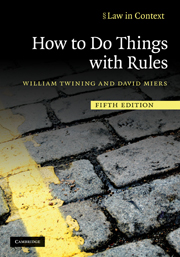Book contents
- Frontmatter
- Contents
- Preface
- Online appendices
- Acknowledgements
- Abbreviations
- Table of statutes and legislative instruments
- Table of cases
- Part I
- Part II Reading, using and interpreting rules in general
- Part III Reading law: reading, using and interpreting legislation and cases
- Part IV
- Index
- Resources on the web
- Appendix I Supplementary materials and exercises on Chapter 1
- Appendix II Normative and legal pluralism
- Appendix III Visual presentation of rules
- Appendix IV The Reading Law Cookbook
- Appendix V Supplementary materials and exercises on Chapters 7–10
- Appendix VI Supplementary materials and exercises on Chapters 9 and 11
- Appendix VII Domestic violence: a case study
- Appendix VIII MPs' expenses: a case study
- Appendix IX Hunting Act 2004: a case study
Appendix V - Supplementary materials and exercises on Chapters 7–10
Published online by Cambridge University Press: 05 June 2012
- Frontmatter
- Contents
- Preface
- Online appendices
- Acknowledgements
- Abbreviations
- Table of statutes and legislative instruments
- Table of cases
- Part I
- Part II Reading, using and interpreting rules in general
- Part III Reading law: reading, using and interpreting legislation and cases
- Part IV
- Index
- Resources on the web
- Appendix I Supplementary materials and exercises on Chapter 1
- Appendix II Normative and legal pluralism
- Appendix III Visual presentation of rules
- Appendix IV The Reading Law Cookbook
- Appendix V Supplementary materials and exercises on Chapters 7–10
- Appendix VI Supplementary materials and exercises on Chapters 9 and 11
- Appendix VII Domestic violence: a case study
- Appendix VIII MPs' expenses: a case study
- Appendix IX Hunting Act 2004: a case study
Summary
This Appendix begins with a short section on alternative methods of classifying legislation. The sections that follow comprise a sequence of increasingly difficult exercises on legislation and its interpretation. In some instances the texts to be studied are provided; in other cases they will need to be found.
Classifying legislation by subject matter (Chapter 7, section 2.7)
There are alternatives to the classification of statutes according to the chronology of their receiving the Royal Assent. Halsbury's Statutes, Halsbury's Laws, and before it was superseded by the Statute Law Database, Statutes in Force, employ subject-based systems: subject-based classification assembles legislation that is considered to belong to a common category under a single title, such as agency, agriculture, ancient monuments and memorials, animals, etc., and within each title is further arranged chronologically. The advantage of this system for the user is that she knows that all the provisions relating to a given matter, such as theft or divorce, will be found under one heading. The disadvantage for the legislative process is that a formal system of this kind will result in a large number of statutes, as amendments would have to be separately enacted where they concern separate subjects. An initial difficulty that affects any subject-based classification concerns the choice of categories that are to be used. Although there are many well-established legal categories, they are neither uncontroversial nor immutable.
- Type
- Chapter
- Information
- How to Do Things with Rules , pp. 457 - 475Publisher: Cambridge University PressPrint publication year: 2010

